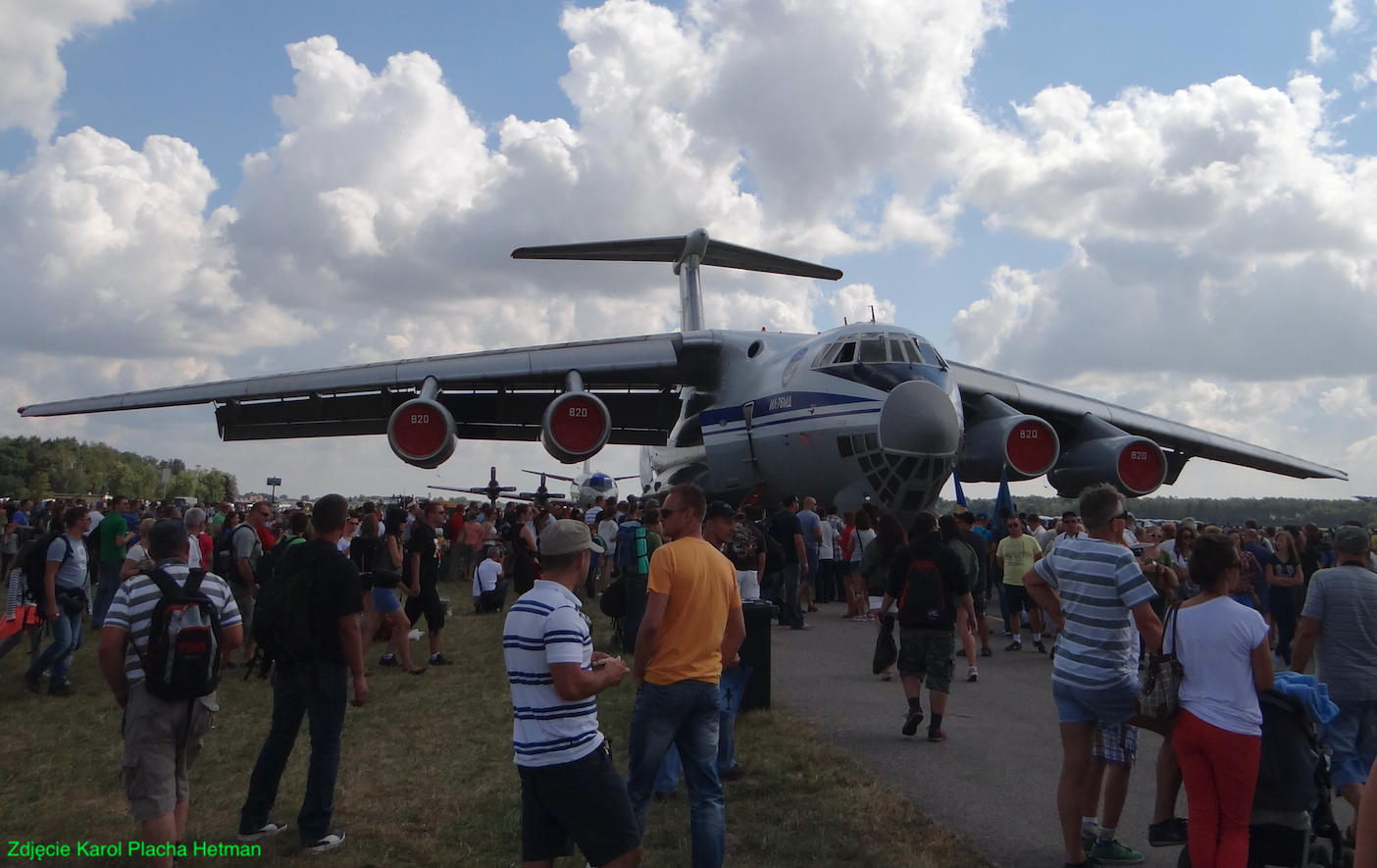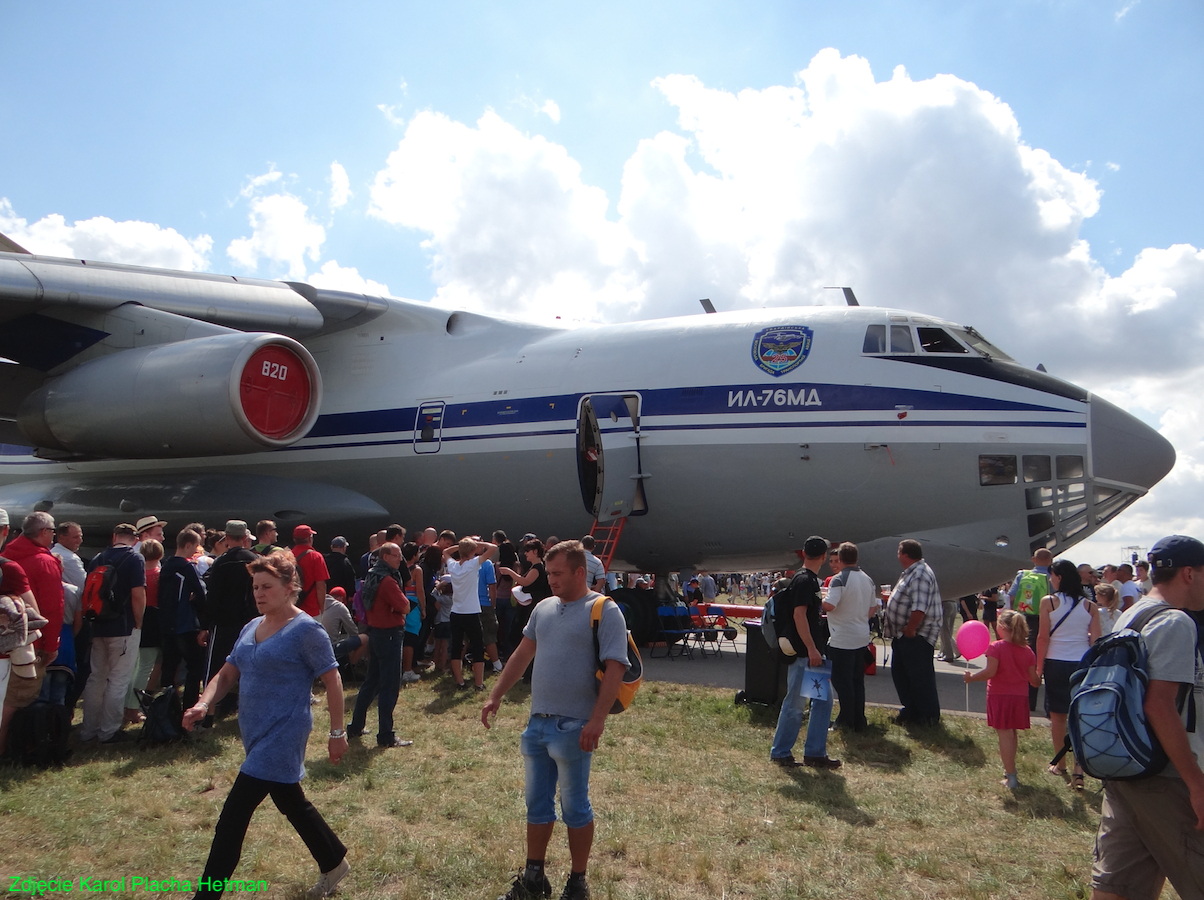Warszawa 2023-04-15
Iliuszyn Ił-76.
The Iliushin Il-76 aircraft is a Soviet transport aircraft that was developed at the end of the 1960s. The aircraft received four turbojet engines and it was the first construction of this type in the Moscow State. The machine replaced Antonov An-12, Antonov An-10 and partly Antonov An-22 aircraft. All previous transport aircraft were powered by turboprop engines. The Il-76 made its first flight on March 25, 1971, and was put into service in 1974. The aircraft were manufactured in Tashkent, Uzbekistan, and approximately 960 were built. The Polish Army has never adopted Iliuszyn Il-76 aircraft.
Development of the Il-76 design.
The 60s of the twentieth century were the peak of the development of aircraft structures in CCCP. Then it got worse every year. Technologies obtained from the West were running out, and the West increasingly protected itself from industrial espionage. At that time, the CCCP’s war doctrine, which assumed attacking Western Europe with all military forces, did not change. To implement this project, transport aircraft were needed, with high payload and capable of operating from ground-surfaced RWY airfields. Therefore, in 1967, Moscow ordered design bureaus to develop a successor to the Antonov An-12 aircraft. Valuable information was provided by the CCCP’s aggression against Czechoslovakia in 1968.
The basic requirement was to transport 40,000 kg of cargo over a distance of 5,000 km. The crossing time was to be up to 6 hours. It was also important to operate in almost all weather conditions.
The design of the Il-76 aircraft, which was modeled on the American C-141 aircraft, was selected for implementation. The aircraft was developed as a high-wing, powered by four turbojet engines, which were placed on outriggers under the wings. Following the example of previous Soviet constructions, a navigator’s station was placed in the nose of the aircraft. As in the An-12 aircraft, the tail gunner station was placed in the tail of the aircraft, which had two 23 mm caliber cannons at its disposal. The wings of the aircraft received rich mechanization of the wing to generate maximum lift at low flight speeds (take-off and landing). The aircraft’s landing gear is completely retractable into the fuselage and has as many as 20 wheels. Access to the cargo hold is provided by the rear loading ramp. There is an additional door on the starboard side, but an added ladder is necessary to get inside.
Versions of Il-76 aircraft.
The Il-76 M is the basic transport version with a load capacity of up to 42,000 kg.
Il-76 MD is an improved transport version. The aircraft has improved equipment.
The Il-76 MD Skalpel is an airborne hospital. Tsar Vladimir Putin uses this type of aircraft.
In the 1980s, the Il-76 aircraft was modified for the role of an air tanker and received the designation Il-78. About 50 were built. These types of planes were bought by Iraq. The aircraft has two devices for transferring fuel in the air in the form of aggregates of the UPAZ-1 type. A flexible hose ends with a basket extends out of the unit’s hopper, inside which a connector is mounted. The unit is controlled by the operator who conducts observations through the side window of the Il-76 aircraft.
The most characteristic is the Il-76/A-50/A-100 aircraft, which is equipped with a characteristic disc-shaped antenna, which is placed above the fuselage of the aircraft, just like in the American AWACS aircraft. Several copies were built. This type of aircraft took an active part in the Smolensk attack on April 10, 2010. Aircraft in the Beriew A-50E/I version were produced for the Indian military aviation. The aircraft were equipped with PS-90 engines. China did not buy A-50 aircraft, but on the basis of the Il-76 aircraft they had, they built their own version of the aircraft with an antenna in a disc above the fuselage.
A variant of the firefighting aircraft was also created. The aircraft has a special water tank installed. The tank can be installed in 1.5 hours. A tank of water has a mass of 23,000 kg. The discharge of water takes place after lowering the rear ramp and opening the valves in the tank. The water drop is relatively slow so that the aircraft does not lose stability. The first tests were carried out in 1990.
The Il-84 was a maritime search and rescue variant that was equipped with two parachute-dropped lifeboats. The boats contained the equipment necessary for the survivors’ survival. Up to 20 people (castaways) could enter the boat at the same time. The predecessor of this aircraft was the Tu-16 bomber, which had this type of lifeboat in the bomb bay.
Former version of the Il-76 (Il-476) aircraft with a glass cockpit, Aviadvigatel PS-90A-76 engines and a new one-piece wing made of composites. Not all tests were performed and due to numerous defects, the aircraft was not put into serial production.
About 20 different variants of the Il-76 aircraft were created for military purposes: reconnaissance, reconnaissance, tests of laser weapons, long-range communication translator, service of military Arctic bases, carrier of cruise missiles released from the aircraft’s hold, studies of the state of weightlessness for astronaut training, observation of artificial satellites of the Earth , testing new turbojet and rocket engines.
The Il-76 aircraft with PS-90A engines made its first flight in 1995. In 2010, a variant of the aircraft with a reinforced airframe structure was developed, which was designated Il-76MD-90A. The main modification consisted in the use of new PS-90A-76 engines, which have a take-off thrust of 4 x 14,500 kG. So each engine has 2,500 kG more thrust than the previous D-30KP-2 engines, and the specific fuel consumption is 12% lower. These engines have a much higher ratio of cold to hot airflow. The parameters of this aircraft have improved. The take-off weight is up to 210,000 kg, and the load carried is 60,000 kg. The armed forces of the Moscow state have ordered 40 new aircraft. Production was started at the Aviatar-SP plant (SP for Planenoye Proizvodstvo) in Ulyanovsk, and not in Tashkent as before. In 2019, the first copy of the aircraft was adopted. By 2020, only 15 were built.
Tests with new turbofan engines were also conducted in China. The engines were marked WS-10A "Taihang". The engines are assigned to the J-10 and J-11 fighters.
Il-76 aircraft were used by the following countries: Algeria, Angola, Armenia, Azerbaijan, Belarus, China, Egypt, India, Iran, Sudan, Syria, Ukraine, Uzbekistan, Iraq, Yemen, Zimbabwe, Armenia, Azerbaijan, Bahrain, Belarus, Kazakhstan , Kyrgyzstan, Laos, Mali, Moldova, DPRK, CCCP/Moscow State, Sierra Leone, Sudan, Syria, Turkmenistan, Ukraine, Uzbekistan, Cambodia, Congo, Cuba, Hungary, Jordan, Lithuania, Serbia.
Data T-T Ił-76 TD:
Crew of 5 airmen. Span 50.5 m (165 ft 8 in). Length 46.59 m (152 ft 10 in). Height 14.76 m (48 ft 5 in). Wing area 300 m2 (3,200 sq ft). Curb weight 92,500 kg (203,928 lb). Il-76M payload weight 42,000 kg (92,594 lb). Il-76MD payload weight 48,000 kg (105,822 lb). Il-76MD-90A payload weight 60,000 kg (132,277 lb). Max takeoff weight 190,000 kg (418,878 lb). The maximum take-off weight of the Il-76MD-90A is 210,000 kg. Top speed 900 km/h (560 mph, 490 knots). Maximum speed Mach 0.82. Range with a load of 4,400 km (2,700 mi, 2,400 nmi). Ferrying range 9,300 km (5,800 mi, 5,000 nmi). Usable ceiling 13,000 m (43,000 ft).
Written by Karol Placha Hetman




